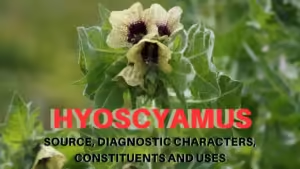Hyoscyamus
Source, diagnostic characters, constituents, tests and uses

Objectives
At the end of this lecture, student will be able to
• Discuss the source, diagnostic characters, constituents, tests and uses of Hyoscyamus
Hyoscyamus
• Consists of matted leaves or leaves and flowering tops with stem
• Pale greyish green colour
• Calmmy and resinous to touch
Synonym
• Henbane, Folia Hyoscyami
Source
• Dried leaves and flowering tops of Hyoscyamus niger
Family
• Solanaceae
Morphology of Hyoscyamus
First Biennial henbane: (Specimen consisting of leaves only)
• Ovate to lanceolate
• More or less broken or crumpled
• 20-30 cm long, 7-10 cm wide
• Petiole- flat, 5 cm long
• Lamina- coarsely dentate
• Apex –acute, acute points at the lobes which are about 5-6 in each side
• Base – acute
• Midrib- broad,
• Trichomes-Glandular, abundant on midrib and principal veins
Second Biennial henbane or flowering tops:
• Consists of more slender parts of stem together with leaves and flowers
Stems:
• Hollow
• Light green
• Covered with glandular trichomes
• Furrows because of shrinkage
• Alternate leaf scars
Leaf:
• Sessile
• Oblong ovate
• Crumpled and broken
• 5-20 cm long, 3-8 cm wide, 2-5 coarse teeth or lobes on each side Base-cordate
• Midrib- broad, flat, with 4-5 veins leaving at right angles, pinnately arranged, terminates at the lobes or teeth
Flowers:
• Crowded together
• Pedicel short – 4 mm long
• Calyx – urceolate with 5 lobes each with an apical spine
• Corolla – funnel shaped, five slightly unequal, rounded lobes yellow with purple veins
• Androceium- purple anthers
• Ovary- bicarpellary, 2 locules
• Ovules- Numerous
• Placentation – Axile
Annual henbane
• Mostly imported drug of poor quality
• Characters similar to that of biennial henbane, but stems are more slender, leaves smaller
Microscopy of Hyoscyamus
Leaf:
• Epidermis with smooth cuticle, anticlinal walls
• Stomata- anisocytic
• Trichomes:
– Covering- conical, uniseriate, 2-4 celled
– Glandular- uniseriate, 2-6 celled, ovoid multicellular and some clavate glandular
Mesophyll:
• (Usually dorsiventral, occasionally isobilateral or undifferentiated)
• Palisade- single layer
• Crystal layer – beneath the palisade layer (Tetragonal prisms, cluster, sandy microsphenoidal)
• Midrib- Meristele surrounded by endodermis with starch
• Narrow arc of xylem, beneath which narrow band of phloem
Constituents of Hyoscyamus:
• Hyoscyamine and traces of scopolamine (hyoscine)
• Total alkaloid- 0.045-0.14 %
• Annual henbane – 0.03 %
• Seeds – 0.05 % (alkaloids present in testa only), 20 % fixed oil
Tests:
• Vitali morin test
Uses:
• Cerebral and spinal sedative
• Does not excite as that of belladonna, hence given in insomnia when opium cannot be given
• Relieves griping caused by drastic purgatives
• Seeds placed over hot coal and vapours produced allowed to enter mouth, is domestic remedy for toothache
Substituents and Adulterants
• H. albus, Continental henbane
• H. muticus, Egyptian henbane
• H. reticulates, Indian henbane
• Leaves of dandelion, Taraxacum officinale (Compositae) –substituted for henbane
• H. aureus, H. pusillus- Hyoscine, principal alkaloid
Also, visit B. Pharma Notes in PDF Free Download.



